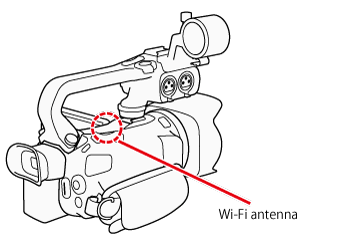Solution
Step 1: Configuring the FTP ServerStep 2: Connect to an Access Point Using Wi-Fi
Step 3: Transferring Files
You can wirelessly transfer files (recordings) directly to a computer or an FTP server. You will need a correctly configured FTP server. During the manual setup procedure, you will need to enter the FTP server's IP address, port, user name, password and file transfer destination (where the files will be transferred to).
To enter text for the various settings, use the virtual keyboard
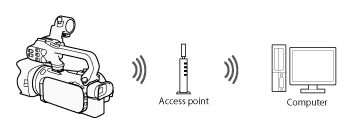
Caution
Step 1: Configuring the FTP Server
1. Set the power switch to ⋖MEDIA⋗.

2. Touch [ 
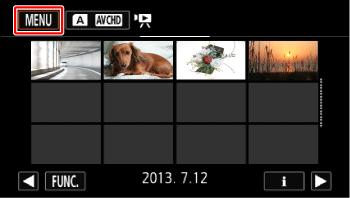
3. Touch [ 
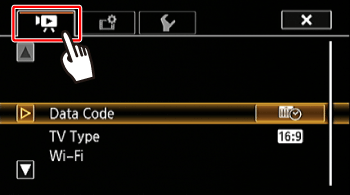
4. 

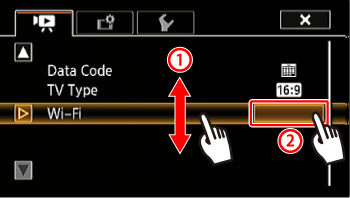
5. Touch [FTP Transfer].
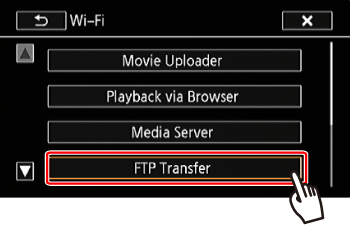
6. Touch [OK].
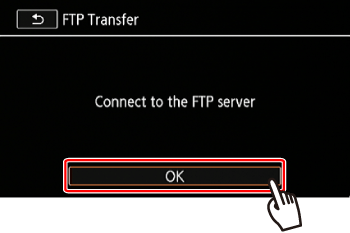
7. Configure the FTP server.



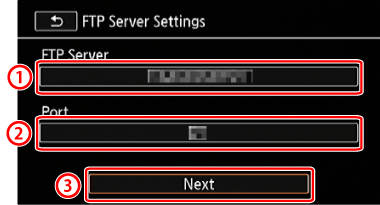
Caution
Using the virtual keyboard
When you need to enter text for various settings, touch the text field and a virtual keyboard will appear on the screen. You must use the touch screen to operate the virtual keyboard. The illustrations below explain the various keys you can use.

















8.



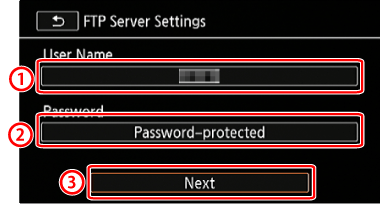
9.


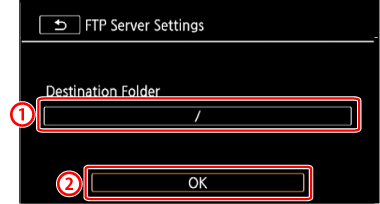
Caution
Depending on the FTP server's settings, the required text for the port number and destination folder may differ. Check the settings on your FTP server.
Step 2: Connect to an Access Point Using Wi-Fi
Connect to an access point.
If you have already completed the settings for connecting to an access point, proceed to Step 3: Transferring Files
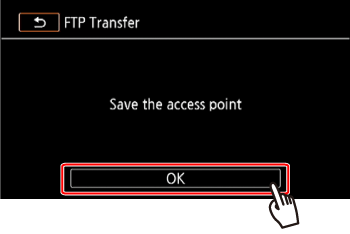
1. Select the desired connection method.
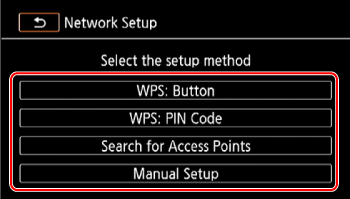
You can select from the following four connection methods.
For more information on your access point, please refer to the access point’s instruction manual.
| [WPS: Button]* | Simply press and hold the WPS button on your access point and then touch the camcorder’s screen. This is the easiest connection method if you are using a WPS-compatible router. |
| [WPS: PIN Code]* | Access the access point’s configuration screen using your Web browser. The camcorder will give you a PIN code, which you will enter into the browser. You will need a WPS compatible router and a computer or other device connected to it. |
| [Search for Access Points] | Following the camcorder’s onscreen instructions, you select your access point from a list of detected SSIDs and then enter your password. |
| [Manual Setup] | You manually enter the access point’s SSID, password and other network settings. This method is recommended for advanced users of Wi-Fi networks.td> |
* WPS, which stands for Wi-Fi Protected Setup, is a standard that makes connecting to an access point easier.

If your wireless router is WPS-compatible, connecting the camcorder to it can be very easy. If you cannot successfully connect the camcorder using WPS, try using the [Search for Access Points] method.
2-a-1. [WPS: Button] method
2-b-1. [WPS: PIN Code] method
2-c-1. [Search for Access Points] method
2-d-1. [Manual Setup] method
Caution
The camcorder can connect to a Wi-Fi network using a wireless router (access point) and even remember the settings for the four most recently used access points.
Caution
General requirements
2-a-1. [WPS: Button] method
Press and hold the WPS button on the access point.
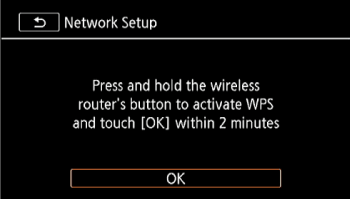
2-a-2. Within 2 minutes, touch [OK] on the camcorder’s screen.
The camcorder will connect to the access point.
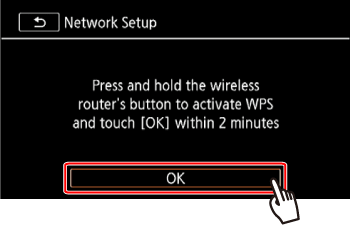
You can touch [Stop] and then [OK] to interrupt the Wi-Fi Protected Setup while it is in progress.
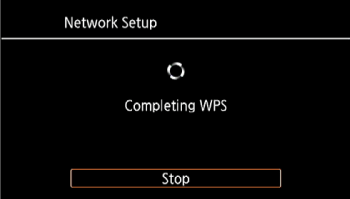
The screen will change when the setting is finished. Proceed to Step 3: Transferring Files
2-b-1. [WPS: PIN Code] method
From a computer or similar device connected to the access point, use the Web browser to open the router’s WPS settings screen. After the 8-digit PIN code appears on the camcorder’s screen, enter it into your router’s WPS settings screen.
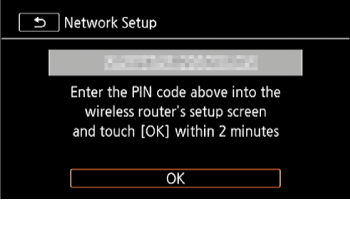
2-b-2. Within 2 minutes, touch [OK] on the camcorder’s screen.
The camcorder will connect to the access point.
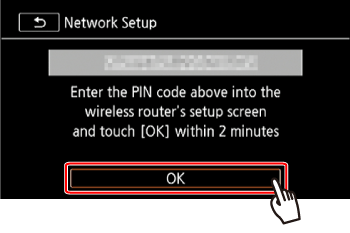
You can touch [Stop] and then [OK] to interrupt the Wi-Fi Protected Setup while it is in progress.
The screen will change when the setting is finished. Proceed to Step 3: Transferring Files

2-c-1. [Search for Access Points] method
The camcorder will automatically detect access points in the vicinity. After you select the desired access point, you simply enter the password (encryption key) to connect the camcorder.
To enter text for the various settings, use the virtual keyboard.
2-c-2. Check the access point setting information.
Note the access point’s network name (SSID) and encryption key.
2-c-3. Select the desired access point
The SSID of detected access points will be displayed.




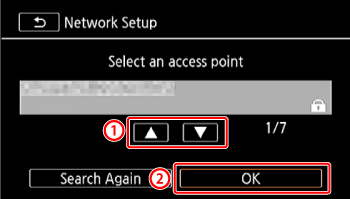
2-c-4. Enter the encryption key (password).
If the access point selected in step 2-c-3 did not have a [ 


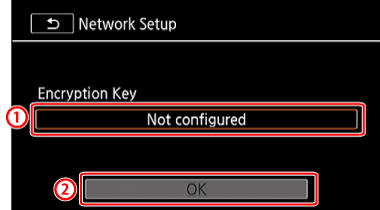
2-c-5. Touch [OK].
The screen will change when the setting is finished. Proceed to Step 3: Transferring Files
2-d-1. Manual Setup
Perform this procedure to manually configure the wireless connection settings. This may be necessary, for example, if your access point’s network name (SSID) cannot be detected due to the stealth function being enabled. Manual setup is for advanced users of Wi-Fi networks.
2-d-2. Enter the SSID.


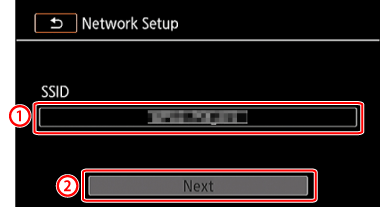
2-d-3. Select the Authentication/Encryption Method.
Touch the [Authentication/Encryption Method] field.
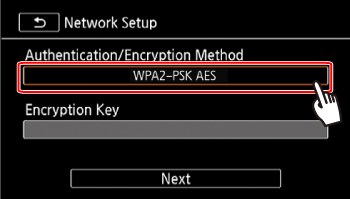
2-d-4. Touch the desired method.
If you selected [OPEN WEP], the WEP index is 1.
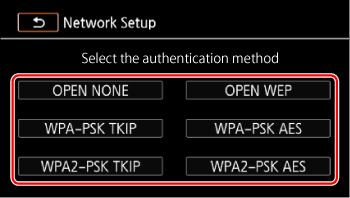
2-d-5. Enter the [Encryption Key]
In step 2-d-4., if you selected [OPEN NONE], entering the encryption key is not necessary.


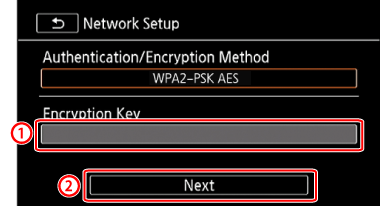
2-d-6. Select how to obtain the IP address.
Touch [Automatic] or [Manual].
If you selected [Automatic], proceed to Step 2-d-12
2-d-7. Set the [IP Address] manually.
Touch the [IP Address] field.
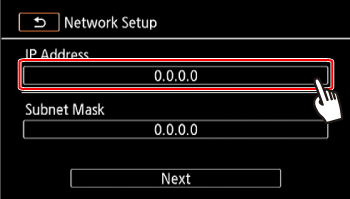
2-d-8. Touch [ 


Enter the following information using the procedure explained above for the IP Address.
2-d-9. Enter the Subnet Mask and touch [Next].
2-d-10. Enter the Default Gateway and touch [Next].
2-d-11. Enter the DNS Server information and touch [Next].
2-d-12. Save the settings.
Touch [OK].
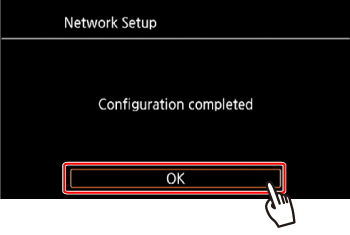
The screen will change when the setting is finished.
Step 3: Transferring Files
1 Transfer Files.



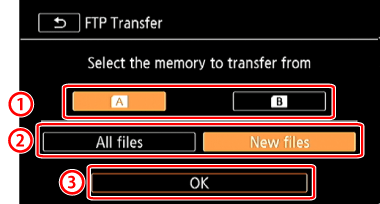
2. Once connected, the wireless transfer will begin.
You can touch [Stop] and then [X] to stop the wireless transfer while it is in progress. However, depending on when you stop the operation, some files will be transferred.
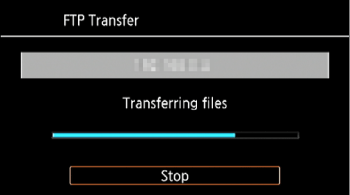
3. Touch [OK].
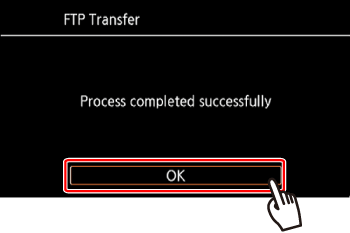
This concludes the procedure for transferring files to an FTP server.
Caution
- Do not open the double memory card slot cover.
- Do not disconnect the power source or turn off the camcorder.
Caution
Depending on the access point's settings and capability, it may take some time to transfer files.
Caution
Caution
About the camcorder’s Wi-Fi standard
The specifications of the camcorder's Wi-Fi standard are as follows.
Wi-Fi protocol, operating frequency: IEEE 802.11b/g/n-compliant, 2.4 GHz
IEEE 802.11a/n-compliant, 5 GHz
Maximum data transfer rate: 11 Mbps (IEEE 802.11b)
54 Mbps (IEEE 802.11a/g)
150 Mbps (IEEE 802.11n)
These are theoretical values and actual data transfer rates may differ.









